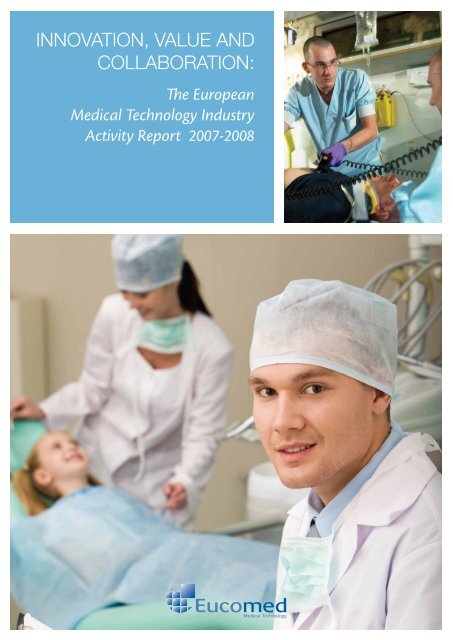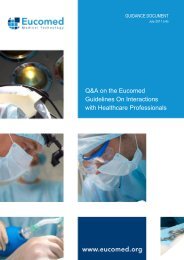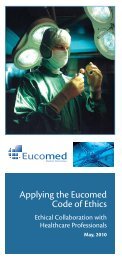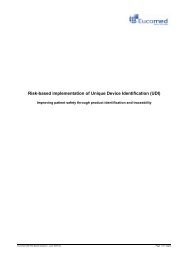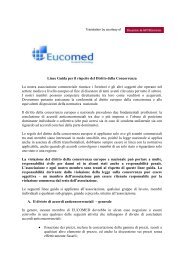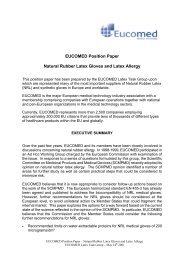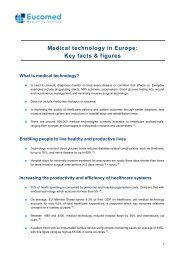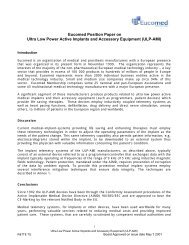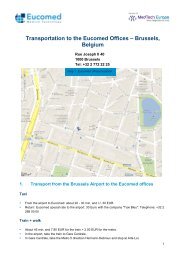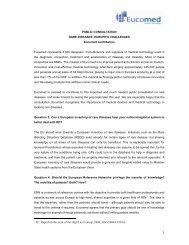Eucomed Activities report 2007-2008
Eucomed Activities report 2007-2008
Eucomed Activities report 2007-2008
- No tags were found...
You also want an ePaper? Increase the reach of your titles
YUMPU automatically turns print PDFs into web optimized ePapers that Google loves.
<strong>Eucomed</strong> - Activity Report <strong>2007</strong>-<strong>2008</strong> | 7“Medical technology is a leading component in theknowledge economy. Looking forward, we want Europeto remain a great place to innovate.”real insight into the socio-economic value of the medicaltechnology sector in order to allow informed policydiscussions to take place. Health economists from leadingacademic institutions are already beginning to deliver onthe initial work streams and at <strong>Eucomed</strong>’s MedTech Forumin October, EHTI presented the results from their first<strong>report</strong> on financing medical devices in Europe.Homecare could one day play a major role in sustainingbroad access to healthcare services as continuedtechnological innovation means that the boundariesbetween hospitalisation and homecare are less distinct.<strong>Eucomed</strong> is contributing to the debate on homecarefunding arrangements which will be the key driver ofpatient access to homecare technology.<strong>Eucomed</strong> plays an important role in safeguardingindustry values by providing guidance to ensure thatrelationships with healthcare professionals remainabove reproach. This commitment was reinforced by theBoard’s recent revision of the Code of Business Practice.The updated Code addresses the change in the dynamicof company-clinician relationships, brought about, inpart, by the growing number of healthcare managementand assessment bodies. Collaboration with healthcareprofessionals remains an essential component of medicaltechnology: feedback from clinicians is a critical driverof innovation and the introduction of new technologiesrequires interaction with health professionals as they learnto realign their practices to use new devices in an optimaland safe manner. <strong>Eucomed</strong>’s Code is complementary andsupportive of our national association members’ efforts toprotect the reputation of the medical technology sector.Medical technology is a leading component in theknowledge economy. Looking forward, we want Europeto remain a great place to innovate. Should our sector’sfull value not be readily apparent to policymakers, it willbecome increasingly difficult to generate investment forthe next wave of innovation. At <strong>Eucomed</strong> we are focusedon raising awareness of the value generated by medicaltechnology’s unsurpassed approach to producing effectiveand safe technologies in a great variety of therapeuticareas, delivering them worldwide and making themaccessible to those who need them.For <strong>Eucomed</strong> members, we want to be more transparent,meaning that all members participate in and agree on theprocesses by which we determine priority issues for theindustry. We also need to leverage our in-house expertiseand to empower our secretariat members to drive projects,with appropriate oversight from the membership.
<strong>Eucomed</strong> - Activity Report <strong>2007</strong>-<strong>2008</strong> | 9About <strong>Eucomed</strong>The voice of the medical technology industry in Europe<strong>Eucomed</strong> represents 4,500 designers, manufacturers and suppliers of medical technology used in the diagnosis, prevention,treatment and amelioration of disease and disability. <strong>Eucomed</strong> members include national trade and pan-European productassociations and internationally active manufacturers of all types of medical technology. The mission of <strong>Eucomed</strong> is toimprove patient and clinician access to modern, innovative and reliable medical technology.<strong>Eucomed</strong> <strong>Activities</strong>Constructive Public Affairs<strong>Eucomed</strong> actively engages with the EU institutions and regulatory bodies to encourage a positive public policyenvironment which is supportive of continuous innovation in medical technology, allowing the sector to optimise itsvalue to patients and society.Enhancing Dialogue<strong>Eucomed</strong>’s stakeholder relations are built upon partnerships with patient groups and medical associations andupon proactive high-profile European events, such as the MedTech Forum -all of which is supported by a range ofcommunication tools and ongoing engagement with media.Providing Market Insight<strong>Eucomed</strong>’s initiatives on health economics provide insight into the value of the medical devices sector by deliveringaccurate data to all stakeholders on the impact of funding and reimbursement systems, on emerging trends such asthe growth of homecare, and the latest industry performance figures.Reinforcing Industry Values<strong>Eucomed</strong> has developed a leading Code of Business Practice, which is implemented by members and is regularlyreviewed and updated.Joining the International Debate<strong>Eucomed</strong> represents the European medical technology sector in international forums, such as the GlobalHarmonization Task Force, and liaises with representative bodies from the US, Japan, China, India, and Brazil.
10 | <strong>Eucomed</strong> - Activity Report <strong>2007</strong>-<strong>2008</strong>Value of Medical Technology to SocietyThe medical technology industry is a major contributor toEurope’s knowledge economy. A dynamic industry, it investsheavily in research and development, creates high-qualityemployment opportunities and is amongst the industrieswhich add most value to the European economy.Healthcare systems are currently facing several challengesthat have to be met in order to sustain broad access tohealthcare services for citizens. Demographic changesare expected to dramatically increase demand for healthservices. Consequently, policy-makers’ concerns are focusedon the adequacy of resources and how best to increase thevalue, efficiency and effectiveness of healthcare.Although the costs of healthcare systems are transparentfor policymakers, there is a lack of awareness regardingthe value generated by investment in new technologies,aside from improved health outcomes. A priority issuefor <strong>Eucomed</strong>, therefore, is to create awareness of howinvestment in new health technology delivers good-valuecare, sustainable medical innovation, and macro-economicgains, such as enhanced productivity.Furthermore, <strong>Eucomed</strong> is raising awareness of how policiesregarding assessment, procurement and reimbursementinfluence the innovation environment and in some caseslimit patient access to the right technology.Continued investment by healthcare systems is neededif Europe is to benefit from groundbreaking innovationsin the medical field being made possible by convergingtechnologies and which offer tremendous newopportunities for diagnosing and treating patients.At a time when Europe is facing major societal, economicand technological challenges, as former EU HealthCommissioner David Byrne put it, “Europe needs aparadigm shift from seeing health expenditure as a cost toseeing effective health policies as an investment. Europeshould look at what health puts into the economy andwhat illness takes out.”
12 | <strong>Eucomed</strong> - Activity Report <strong>2007</strong>-<strong>2008</strong>Economic Contributionand Sustainable DevelopmentComprising of more than 11,000 companies employingapproximately 435,000 people and with total revenuesof €72.6bn, the European medical technology industryis a major contributor to EU wealth and employment.Growth looks set to continue as the population of Europecontinues to increase its life expectancy resulting in asignificant increase in demand for medical technologiesand treatments to secure the well-being of the ageingpopulation.<strong>Eucomed</strong> regularly produces <strong>report</strong>s highlighting the keymacro-indicators based on primary data received from itsmembership. However, the full value and impact of medicaltechnology is significantly underestimated. Recognisingthe existing knowledge gap, <strong>Eucomed</strong> has teamed up withleading academic institutions and EU policymakers tofound the European Health Technology Institute for Socio-Economic Research. This independent research instituteis beginning to deliver insight into the full social andeconomic value of medical technology and its impact onthe economy and welfare of European countries.“<strong>Eucomed</strong> encourages investment in the Europeanmedical technology industry for the benefit of patients,customers, employees and member companies.”
<strong>Eucomed</strong> - Activity Report <strong>2007</strong>-<strong>2008</strong> | 13Key Facts and Figures<strong>Eucomed</strong> data provides an insight into the dynamic role played by the medical technology sector in driving Europe’sknowledge economy. The <strong>report</strong>ed figures only provide part of the picture as they do not attempt to quantify theresult of innovation in medical technology, namely, the provision of solutions to clinical needs which save andtransform patients’ lives.• The medical technology sector <strong>report</strong>s annual salesof €72.6bn. Europe represents one third of the globalmedical devices market of €187bn and is the secondlargest market after the US.• Medical technology is one of the most innovativeindustries in Europe. Up to 8% (or €5.8bn) of medicaltechnology sales are reinvested in R&D. Productshave an average life cycle of only 18 months before animproved product is developed.• The medical technology sector employs 435,000 peopleacross Europe and it is growing at an annual rate ofbetween 5% and 6%.• Unlike the pharmaceutical industry, Small and MediumEnterprises (SMEs) predominate in the medicaltechnology sector, generating over 80% of revenues.• In Europe, 6.8% of total health expenditure goes tomedical technology. Average spending per head onhealthcare is €2,173 and of this, €145 is spent onmedical technology.Total Healthcare Expenditure (THE) and Expenditure on Medical Technology (EMT)CountryPopulation(1,000)THE(€ Bn)THE/GDPTHEper Capita (€)EMT(€ Bn)EMTper Capita (€)EMT/THEAustria 8.233 25,0 9,8% 3.032 1,76 213,77 7,0% 1,79 +Belgium 10.479 30,5 9,8% 2.911 2,80 267,20 9,2% 1,70 -Bulgaria 7.699 1,6 6,5% 214 0,13 16,24 7,6% 0,05 -Cyprus 773 0,8 5,4% 1.027 0,04 52,67 5,1% 0,04 -Czech Republic 10.221 7,1 7,2% 692 0,54 53,28 7,7% 0,47 -Denmark 5.416 18,8 8,6% 3.466 1,30 240,03 6,9% 2,20 +Estonia 1.344 0,6 4,2% 415 0,10 72,36 17,4% 0,06 -Finland 5.246 11,8 7,1% 2.249 0,53 101,03 4,5% 0,85 +France 60.873 190,1 10,7% 3.123 10,06 165,26 5,3% 9,44 -Germany 82.466 238,3 10,4% 2.890 20,20 244,95 8,5% 25,91 +Greece 11.104 22,9 9,4% 2.061 0,78 70,67 3,4% 0,01 -Hungary 10.087 6,6 7,4% 653 0,54 53,77 8,2% 0,46 -Ireland 4.131 12,0 7,5% 2.912 0,41 98,61 3,4% 5,95 +Italy 58.135 132,4 9,0% 2.278 6,20 106,65 4,7% 2,59 -Latvia 2.288 0,7 4,4% 306 0,09 37,40 12,2% 0,03 -Lithuania 3.394 1,2 5,0% 349 0,13 38,24 11,0% 0,09 -Luxembourg 455 2,5 7,4% 5.386 0,06 128,13 2,4% 0,06 -Malta 406 0,4 7,9% 984 0,03 66,75 6,8% 0,03 -Netherlands 16.320 44,4 8,5% 2.721 2,50 153,02 5,6% 3,04 +Norway 4.661 21,9 8,2% 4.699 1,04 222,63 4,7% 0,80 -Poland 38.161 15,0 5,6% 394 1,20 31,45 8,0% 0,62 -Portugal 10.563 15,1 9,8% 1.431 0,72 68,16 4,8% 0,44 -Romania 21.588 3,8 3,8% 174 0,17 7,91 4,6% 0,03 -Slovakia 5.387 2,7 6,1% 499 0,24 44,45 8,9% 0,15 -Slovenia 2.007 2,3 7,6% 1.150 0,21 102,94 9,0% 0,16 -Spain 43.398 74,4 7,7% 1.714 6,00 138,26 8,1% 3,67 -Sweden 9.030 25,9 8,4% 2.865 1,38 152,82 5,3% 1,77 +Switzerland 7.484 34,2 11,0% 4.568 1,68 223,97 4,9% 5,06 +United Kingom 60.227 147,0 7,7% 2.441 11,75 195,10 8,0% 11,94 +EUROPE 501.575 1.089,8 8,5% 2.173 72,57 144,69 6,8% 79,43 +United States 296.410 1511,0 15,3% 5.098 97,96 330,49 6,5% -PMT(€ Bn)TradeBalanceSource: OECD, <strong>Eucomed</strong> Member Associations, Medistat, and <strong>Eucomed</strong> CalculationsPMT = Production of MT | THE = Total Healthcare Expenditure (total personal expenditure on healthcare + total expenditure on collective services + investment into medical facilities)EMT = Expenditure on Medical Technology | European averages weighted by population size
14 | <strong>Eucomed</strong> - Activity Report <strong>2007</strong>-<strong>2008</strong>Imports and Exports of Medical TechnologyAustriaBelgiumBulgariaCzech RepublicDenmarkEstoniaFinlandFranceGermanyGreeceHungaryIrelandItalyLatviaLithuaniaNetherlandsNorwayPolandPortugalRomaniaSlovakiaSloveniaSpainSwedenSwitzerlandUnited Kingom€0 €5.000.000.000€407.836.458€440.000.000€3.200.000.000€2.100.000.000€96.766.486€21.105.448€522.410.171€448.121.551€1.300.000.000€2.200.000.000€75.979.611€43.086.970€485.100.000€807.800.000€810.369.544€40.618.031€167.330.360€249.522.141€1.590.258.863€71.201.019€20.229.372€90.793.246€53.520.229€697.000.000€52.000.000€1.000.000.000€420.000.000€350.000.000€70.000.000€171.710.736€26.600.828€179.277.515€91.375.455€151.799.936€105.288.308€2.333.432.994€1.416.419.000€1.184.140.370€1.569.920.771€1.958.744.823EUROPETotal Imports€51.676.696.855€3.742.000.000€7.691.183.201€7.075.591.796€6.200.000.000€7.133.256.332€5.942.358.069€7.088.244.664€7.630.455.559€5.339.359.669€6.420.000.000€6.610.000.000EUROPETotal Exports€57.415.512.675ImportsExportsSource: <strong>Eucomed</strong> Member Associations and MedistatThe market data presented in the <strong>Eucomed</strong> activity <strong>report</strong> are estimationsand <strong>Eucomed</strong> does not guarantee the source, accuracy or reliability of the datapresented. <strong>Eucomed</strong> and its agents shall not be held liable for any damage whatsoever,which may arise as a result of errors or omissions in the marketdata information€10.000.000.000€11.200.000.000Green PublicProcurementBackground• The European Commission, in conjunction with localgovernment organisations, has developed a numberof green purchasing toolkits for public purchasers indifferent market sectors.• Green public procurement means that environmentalfactors are taken into account when buying products,services or works. The aim is to leverage the influence ofpublic authorities – whose annual budget is equivalentto 16% of the EU’s GDP or €1,600bn – in order tostimulate the production of more environmentallysustainable products.• <strong>Eucomed</strong>’s Environmental Focus Group has led theindustry response to the Commission’s draft documentwhich addressed a range of products used in thehealthcare sector, including certain medical devices.• <strong>Eucomed</strong> highlighted that the Commission’s draft<strong>report</strong> focused primarily on safety concerns, manyof which were already being addressed by existingEuropean Directives, and did not consider thefundamental principle of risk-benefit analysis appliedwhen designing medical devices.• Following a constructive dialogue with the Commission,the medical device industry agreed to present its ownproposal for an environmental assessment of medicaldevices prior to the publication of the Commission’s‘Green Public Procurement’ criteria.
<strong>Eucomed</strong> - Activity Report <strong>2007</strong>-<strong>2008</strong> | 15
16 | <strong>Eucomed</strong> - Activity Report <strong>2007</strong>-<strong>2008</strong>InnovationThe medical technology sector is highly innovative andis a major contributor to Europe’s knowledge economy.Substantial investment in research and development placesthe medical technology sector amongst the industrieswhich add the most value and drive growth in Europe.Innovation and medical technology have becomesynonymous terms: the sector’s more than 500,000 differentproducts now have an average life cycle of just 18 months.This ongoing commitment to innovation enhances thequality and efficacy of care for the billions of patientsworldwide that depend on medical technology, be it athome, at the doctor’s or in hospital.As Europe still lags behind the US and Japan in terms ofinnovativeness, and, more importantly, medical technologyinnovations are expected to fundamentally transform thehealthcare landscape over the next 10 year, it is critical thatthe sector continues to move forward.Medical technology breakthroughs will be facilitated by theincredible progress being made in a number of scientific andtechnical arenas. The rewards of converging technologies inmedical devices are great, not only in meeting the demandsof an increasingly well-informed patient population,but also in addressing the cost-effectiveness concerns ofgovernments and society.Just as it has been a global leader in the past with thedevelopment of important products such as the pacemakerand hip implant, Europe must seize the opportunity to be atthe forefront of medical technology innovation. <strong>Eucomed</strong> isengaging with a range of stakeholders in actively promotingan innovation agenda.
<strong>Eucomed</strong> - Activity Report <strong>2007</strong>-<strong>2008</strong> | 17Supporting the InnovatorsInvestment in healthcare technology provides a range of benefits from earlier disease detection and better treatmentand prognosis, to more efficient healthcare delivery resulting from reduced hospital stays, faster recovery ratesand increased productivity of former patients. <strong>Eucomed</strong> has a number of EU policy recommendations which ifimplemented would increase competitiveness and create high-quality employment in Europe.• Far better financial support mechanisms are requiredfor entrepreneurial innovators and the EU shouldencourage Member States to take appropriate action.When prioritising EU-funded research, additionalweight should be given to those projects whose positivecontribution to patient outcomes will impact thegreatest amount of individual patients.• European Framework Programmes need to increasetheir focus on medical technology innovation. Theadministration of, and access to, R&D programmesshould be greatly simplified in order to better supportthe research-intensive SMEs that are driving some of themost exciting new treatments for patients.• Intellectual property protection is an absoluteprerequisite for technological progress. Innovatorswould welcome European Commission steps, inconjunction with the EPO, to simplify existing patentprocedures. An EU Community patent would also besupported.• Measures are needed to prevent counterfeit medicaltechnology products gaining access to Europeanmarkets and work is needed at the international level toseek a global solution to this increasing problem.• <strong>Eucomed</strong>’s response to the Lisbon Agenda - the EUleaders’ initiative to make Europe the world’s leadingknowledge-based economy - highlights the role ofinnovation in meeting key challenges, such as the ageingpopulation and low-cost manufacturing conditionsoutside the EU.MedTech Innovation TrendsConvergence and increased collaboration enables the medical technology industry to harness the increasing powerand sophistication of sectors such as materials science and microelectronics, leading to groundbreaking new products.• Miniaturisation of Medical Devices - will allow moreminimally-invasive and non-invasive procedures andhelp move treatment along the continuum of care, fromhospitals to outpatient settings.• Replacement Organs - will provide radical new optionsto address the most serious disease conditions.Examples include, an artificial pancreas which combinesskin-based sensors to measure blood-glucose levels, ahandheld computer to analyse the information, and animplantable infusion pump that adjusts glucose levelsas needed and that will provide diabetics with a moreaccurate and less painful way to monitor and treat theircondition.• Molecular and Gene-Based Diagnostics - will detectdiseases earlier in their progression, improving patientoutcomes and lowering treatment costs. Examplesinclude molecular imaging diagnostic tests that detectcancers and other diseases at the molecular level.• Health Information Technology - will allow criticalmedical data to be processed and transmitted rapidlyover great distances which will speed up the deliveryof treatment, saving both patients and physicians time.Increasingly devices such as pacemakers and bloodglucosetest kits will be monitored remotely via wirelessconnections.
<strong>Eucomed</strong> - Activity Report <strong>2007</strong>-<strong>2008</strong> | 19
20 | <strong>Eucomed</strong> - Activity Report <strong>2007</strong>-<strong>2008</strong>Importance of Decision MakingIdentifying the optimal allocation of resources in order tosupport medical innovation and maximise health gainsis a key challenge for healthcare systems. It has arguablynever been more important as Europe’s economic outlooktightens and healthcare systems prepare themselves for theimplications of an ageing population. Demographic changesand the rise of chronic longevity-related diseases willdramatically increase demand for health services.As policymakers seek solutions to sustain universalaccess to healthcare services, <strong>Eucomed</strong> is sheddingsome much needed light onto the financing of medicaldevices in Europe. The objective of <strong>Eucomed</strong>’s work onHealth Technology Assessment (HTA), procurement andreimbursement is to promote greater understanding of howthese systems interact, how they impact on innovation andultimately, how they influence patient access to the latesthealthcare technology.HTA is playing an increasingly important role in determiningwhich medical technologies are available to patientsthroughout Europe. Unlike regulatory approval concerningthe safety of new devices, HTA decisions depend on localtreatment practices, local funding levels and socio-culturalfactors. <strong>Eucomed</strong> is working with HTA agencies to ensurethat the specificities of the medical devices sector arefully recognised and assessments do not simply transferthe approach applied to pharmaceuticals or other healthservices.“HTA is playing an increasingly important role indetermining which medical technologies are available topatients throughout Europe.”
<strong>Eucomed</strong> - Activity Report <strong>2007</strong>-<strong>2008</strong> | 21Health Technology AssessmentHealth Technology Assessment (HTA) should support patient access to innovative technologies by promoting the useof technologies that are clinically effective and cost-effective. In endorsing the value of HTA, <strong>Eucomed</strong> has outlined theprinciples necessary if HTA assessments are to introduce a new paradigm for managing healthcare resources, one thatseeks to invest in innovation and create value in Europe.• Transparency & Stakeholder Involvement:The HTA process should be transparent and encouragethe involvement of relevant stakeholders includinghealthcare practitioners, healthcare planners/payers,patients and technology manufacturers at all stages ofthe process.• Harmonisation of HTA: Harmonisation of approachand evidence requirements are partially possible(systematic evidence review, alignment on keyprinciples of process and methods) and the EUnetHTAis helping to build consensus between HTA bodies.However, the decision outcomes and application of“The HTA process should be transparent and encouragethe involvement of relevant stakeholders.”• Widening the Perspective: Although healthcaredecision makers’ primary focus is on the impact ofnew technologies on healthcare budgets, HTA agenciesshould be encouraged to adopt a broader perspectiveand consider the impact of technologies on societalcosts, such as productivity and social care costs.• Timing of HTA: HTA bodies need to balance thedemands for early assessment with the availability ofdata on new technologies. Discussion between themanufacturer and HTA agency should seek to identifythe optimal time to undertake HTA. This is particularlyimportant for devices associated with a ‘learning curve’effect whereby their effectiveness can only be properlyevaluated once healthcare professional, have adjustedtheir practice to incorporate the new technology, e.g.devices intended for surgical use. HTA is an iterativeprocess and should be revisited at relevant times inthe life cycle of a technology to take into accountimportant new evidence.HTA bodies should remain at national and regionallevels due to differences in levels of healthcare funding,healthcare priorities and treatment pathways.• HTA to Guide Investment: Policymakers have anopportunity to fundamentally transform the healthcarelandscape. HTA should not become a barrier to marketentry or a support to the traditional cost-controlview of healthcare, rather it should be used to guideinvestment in healthcare and to maximise the deliveryof high-quality, innovative care to patients.
22 | <strong>Eucomed</strong> - Activity Report <strong>2007</strong>-<strong>2008</strong>Reimbursement & ProcurementEuropean healthcare systems vary significantly; each country has its own way of organising, funding and deliveringhealthcare services. To what extent do differences in the level of centralisation/decentralisation, differences in theregulation of healthcare services and products and differences in funding mechanisms affect the introduction and rollout of new technology to those in need? <strong>Eucomed</strong> is analysing reimbursement and procurement systems in order tofacilitate informed debate on the advantages and disadvantages inherent to each system.ProcurementIn most European countries, the role of publicprocurement and centralised purchasing within thehealthcare sector is growing significantly. There areprofound effects for the medical technology industry, inparticular, given the introduction of political objectiveswhich change the rules of engagement. Procurementsystems are now mainly being driven by costcontainmentand performance-oriented goals.The indications are that the trend that has seenpurchasing power move from the hospital to the regionalor national level will continue and that more purchasingconsortia will be established, as has been the case inGermany, the UK and Italy. <strong>Eucomed</strong> analyses thesedevelopments in order to produce evidence-basedopinions as to the true effectiveness of the new schemes.In addition to monitoring if the expected advantages,such as decreasing costs, process standardisation andinter-institutional relationship enhancement, are actuallytaking place, <strong>Eucomed</strong> also looks at the impact of thesedevelopments on different healthcare stakeholders andinnovation in the marketplace.ReimbursementRecent <strong>Eucomed</strong> and EHTI <strong>report</strong>s have providedcomprehensive and comparative insight into medicaltechnology financing policies and processes and therelated impact they have on the diffusion of new medicaltechnology, patient access, health system efficiency andinnovation.Preliminary findings unveiled high variability in uptake oftechnology both across and within national boundaries.Such variations may be explained by the differentreimbursement schemes, although physicians alsoplay a significant role in the adoption and use of newtechnology.One issue highlighted by the case studies was the lack ofregular and timely updating of the list of reimbursementtariffs. This has several implications, including theobsolescence of the models included on the lists andthe risk of inappropriate prescribing and use of thetechnology. There is also a lack of transparency regardingthe formal application procedures to allow newtechnologies to be considered for approval.Regardless of the healthcare system and its financialarrangement (i.e. global budget or Diagnosis-relatedGroup), it was generally believed by thought-leadersthat governments inadequately put forth appropriatefinancing or policy levers to promote technologicalinnovation, especially in the hospital sector.
<strong>Eucomed</strong> - Activity Report <strong>2007</strong>-<strong>2008</strong> | 23
26 | <strong>Eucomed</strong> - Activity Report <strong>2007</strong>-<strong>2008</strong>Changing LivesThe impact of medical technology is most keenly felt at anindividual level. Whilst healthcare policy considerationsinevitably focus on broad, systemic issues, the patientviewpoint is a lot more precise, namely, “is my conditiontreatable?”More and more often the answer is “yes”. As one of themost innovative industries in the world, medical technologyevolves constantly to improve, transform and save lives.Today, patients worldwide see the value of medicaltechnology in a range of settings, be it in their home, at thedoctor’s, in the hospital or in the nursing home.it is impossible to quantify the human and emotionalbenefits felt by patients and their families that result fromimproved health outcomes.By making the impossible possible, medical technologyis providing hope where previously none existed. Thepositive psychological impact for sufferers is enormous.<strong>Eucomed</strong> members are behind innovation-led trends suchas minimally-invasive surgery, rapid and effective diagnosticsand remote patient monitoring. The result is better qualityof life, reduced disability levels, and decreased mortalityrates for patients everywhere.For individual patients, medical technology means quickerrecovery times and the alleviation of pain, injury orhandicap. Whereas research is increasingly demonstratingthe extent to which prevention, early detection andeffective treatment leads to a healthier, wealthier society,
<strong>Eucomed</strong> - Activity Report <strong>2007</strong>-<strong>2008</strong> | 27Brain DisordersA number of health disorders are related to the brain, including: migraine; epilepsy; dementia and brain aneurysm.According to European Brain Council figures, 127 million Europeans were affected by a brain disorder in 2005 and thetotal annual cost of brain-related diseases is approximately €386bn.Case Study: Parkinson’s DiseaseMike Robins, UK• It took two years before what started as a slight twitch in Mike Robins’ shoulder was correctly diagnosed asParkinson’s Disease.• “It really knocked the stuffing out of me. I lost all my confidence. I would cry spontaneously. My life wasthoroughly miserable”, he recalls.• Treatment like diagnosis was hard to obtain: drugs did not work or produced unpleasant side effects.• Mike can vividly remember the moment, during the operation to implant a neurostimulator in his brain, when hislife changed for the better - “I was required to be awake during the operation. I was shaking, as the probe hit thespot, twelve centimetres into my brain that the surgeon had been aiming for, I was suddenly as steady as a rock.”ObesityObesity is one the major health challenges worldwide and has become an epidemic over the last decade. The numberof obese Europeans has tripled over the last 20 years, amounting to 130 million citizens. Obese people are more likelyto develop certain diseases including bone and joint disorders, diabetes type II, coronary heart diseases, certain typesof cancer, as well as psychological problems. As a result, obese people have a lower life expectancy. Obesity not onlyaffects the individual, but has economic implications for the whole of society. About 6% of European health costs areattributable to treatment of obesity and related complications.Case Study: Gastric BandingAnne-Marie, The Netherlands• “About ten years ago, during puberty, my weight increased rapidly. I started following different diets and takingpills. Initially, I lost weight, but shortly after, I gained even more weight,” explains Anne-Marie.• “This made me feel depressed; I didn’t know what was wrong with me. I experienced one anger attack after theother until I decided, back in 2001, to visit my physician. He confronted me with my obesity and suggested thepossibility of gastric banding.• Two years later I had my operation. In the weeks immediately following the operation I started losing weight.I felt more active, took up sports and went cycling with my children.• Before my operation, I weighed 123 kg, now I weigh 68 kg. 55 kg makes a world of difference. I no longer feeldepressed and I look so much better. Gastric banding has truly saved my life.”
28 | <strong>Eucomed</strong> - Activity Report <strong>2007</strong>-<strong>2008</strong>SafetyPatient safety is a critical component of quality healthcare.Unsafe medical care is a major source of concern: nearly onein ten patients is harmed while receiving healthcare in wellfundedand technologically advanced hospital settings.<strong>Eucomed</strong> is actively involved in highlighting awarenessof healthcare safety issues. The illusion of cost saving isdriving the worrying trend of inappropriate reprocessing ofinjury and diagnostic error. Occupational safety concernsfor healthcare workers are also a real concern: the issue ofneedlestick injuries which was previously ‘below the radar’ isnow being addressed by EU policy-makers.The European Commission is moving safety up the agendawith its Communications on Patient Safety and on the highprofile issue of Healthcare-Associated Infections (HCAIs).“Unsafe medical care is a major source of concern.”single-use sterile medical devices. Devices which for medicalreasons are designed for single use are being reused withoutthe knowledge or consent of the patient or the healthcareprofessionals responsible for treating the patients. Thisdangerous policy raises profound ethical questions andsubstantially increases the risk of patient contamination,<strong>Eucomed</strong> provides a constructive input to the policymakingprocess. Most safety concerns can be allayed throughappropriate regulatory action and continued innovation inthe medical technology sector.
<strong>Eucomed</strong> - Activity Report <strong>2007</strong>-<strong>2008</strong> | 29Reuse of Single-Use DevicesA growing number of hospitals are engaged in the dangerous practice of reprocessing single-use sterile medicaldevices (SUDs) in misguided attempts to economise. SUDs are not designed to be disassembled, decontaminated,reassembled and reused. Reuse jeopardises safety with potentially severe consequences for patients: increasedrisk of infection, injury and diagnostic errors are often the result. Such unacceptable standards of care ultimatelyincrease societal costs. <strong>Eucomed</strong> is engaging with a range of stakeholders to raise awareness and ultimately to see thereprocessing of SUDs prohibited in the European Union.Reprocessing Case Study: Balloon Catheter• A balloon catheter is used to enlarge a narrow opening or passage within the body during a medical procedure.It is made out of special elastomers chosen for their softness when in contact with the body and may have aspecial coating to ensure the best performance for single use in the blood stream.• A study of reprocessed balloon catheters awaiting reuse found that 50% were contaminated with blood andother materials. Besides the risk of contamination (e.g. hepatitis ,HIV), such residues can also cause feverreactions.• The analysis also revealed that up to 45% of the devices showed surface changes and defects caused by multipleusages, reprocessing or inadequate packaging. In addition to the risks of cross-infection from blood and/orprotein residues, the surface damage can pose a risk of thrombosis. The weakened device may break during theprocedure, which brings enormous risks for the patient resulting in additional surgical intervention.“Reuse jeopardises safety with potentially severeconsequences for patients: increased risk of infection,injury and diagnostic errors are often the result.”
30 | <strong>Eucomed</strong> - Activity Report <strong>2007</strong>-<strong>2008</strong>Healthcare-Associated InfectionsEurope urgently needs an effective strategy to dealwith a Healthcare-Associated Infections (HCAIs) whichconstitute an increasing proportion of the overall burdenof disease. The European Centre for Disease Preventionand Control has indicated that HCAIs, particularly thosecaused by drug resistant microbes, are possibly thebiggest infectious disease challenge facing the EU.<strong>Eucomed</strong> members are active in the debate and believethat this health crisis requires pan-European leadershipand co-ordination. Solutions will need to encompass EUhealth and employment policies as adequate protectionis needed for both patients and healthcare workers.The European Commission and Member States needto adopt rapidly appropriate measures in order tosignificantly reduce the risk of exposure to thesepotentially fatal infections. Agreed standards should bebased on examples of best practice.The medical technology industry supports the fourprongedapproach, as outlined by Health First Europe.To control and manage HCAIs emphasis must be placedon: developing effective surveillance and understandingof HCAIs; early detection and preventative measures,better provision of education about HCAIs forhealthcare providers, and the increased use of innovativetechnologies and services designed to reduce thelikelihood of infection.HCAIs• Three million cases per annum in Europe, resulting in 50,000 deaths.• Up to 30% of HCAIs thought to be preventable.• Direct and indirect annual costs of HCAIs estimated at more than €11bn.Occupational Risks: Needlestick InjuriesThe medical technologies work on safety is not limited to patient-focused issues. <strong>Eucomed</strong> members have investedsignificantly in developing innovative technology solutions to help prevent occupational needlestick injuries that canlead to potentially fatal blood borne infections, such as Hepatitis C, Hepatitis B and HIV.Case Study: Needlestick Injury• Healthcare professionals are exposed to blood borne infections in the line of duty. The most common form ofexposure is via ‘needlestick’ injuries (whereby a used syringe pierces the worker’s skin).• More than 20 dangerous blood borne pathogens can be transmitted by contaminated needlesticks, includingHepatitis and HIV.• The European Parliament estimates that there are more than 1 million needlestick injuries in healthcare workerseach year in Europe.• Efforts to reduce the level of injuries focus on safety education, safer working practices and the use of medicaldevices that incorporate needle protection mechanisms.• <strong>Eucomed</strong> members have improved needle protection technology by introducing shielding, retraction or bluntingfeatures which help to prevent needlestick injuries.
<strong>Eucomed</strong> - Activity Report <strong>2007</strong>-<strong>2008</strong> | 31
32 | <strong>Eucomed</strong> - Activity Report <strong>2007</strong>-<strong>2008</strong>Access to TechnologyMedical technology improves and transforms patients’ lives.From cardiac pacemakers to hearing aids to modern incontinenceproducts, medical devices are indispensable to theprovision of modern, high-quality healthcare in Europe.procurement and reimbursement arrangements ofteninhibit patient access to the latest technologies and caninadvertently act as a brake on innovation.“<strong>Eucomed</strong> research indicates that the treatmentsetting has a big influence on patient and healthcareprofessional access to medical technology.”In all, the medical technology sector produces over 500,000products which can be divided into 10,000 generic groups.However, in an era of ageing populations and growinghealth expenditure, continued progress can not be taken forgranted: healthcare systems are under mounting pressure.Whereas moves to promote cost-effective technologyare supported, healthcare reforms also need to includestructural issues within their scope. National and regional<strong>Eucomed</strong> research indicates that the treatment setting– whether a medical technology is considered as part of ahospital-based episode of care, part of a service delivered byan office-based GP or specialist, or a health benefit – has abig influence on patient and healthcare professional accessto medical technology. With homecare increasingly beingseen as key to sustaining broad access to healthcare services,policymakers need to consider whether healthcare systemswill support continued innovation in this area.
<strong>Eucomed</strong> - Activity Report <strong>2007</strong>-<strong>2008</strong> | 33Focus on Homecare: eHealtheHealth is a joint effort by healthcare professionals, the medical technology industry and the ICT industries to findbetter and more cost-effective solutions to diagnose, treat and prevent disease and injury.• Annually, around 500,000 patients in the EU receiveimplantable devices that help to regulate their heartbeat.• Telemetry functionality means that monitoring can nowbe done remotely, i.e. patients are no longer obliged tovisit physicians as automated data transmission can occurover the phone. This offers immense benefits, rangingfrom savings on travel cost and time for the patient tothe freeing-up of physician’s consultation time.• Only 1% of all eligible patients are actually monitoredremotely.• Inappropriate financial incentives provide a key barrier tothe uptake of telemonitoring. Cost elements - includingthe transmitter in the patient’s home, the cost oftransmitting data and costs at the physician’s end of thechain - span different budgets, ranging from the hospital,which usually pays for the device, to the ambulatorysetting, i.e. the patient’s home.• The net result is that the potential to save money andsimultaneously deliver better care is not being realised.• While eHealth strategies are currently beingimplemented nationally, the European Commission’sCommunication on Telemedicine is building expectationby tackling issues such as legal obstacles, data protectionand privacy, and patient reimbursement.Interview: Roy BridgesHealth First Europe (HFE) is working to ensure thatequitable access to the best healthcare treatments is seenas a vital investment in the future of Europe. Advisory andExecutive Committee member Roy Bridges highlights somerecent initiatives.How does HFE contribute to European healthcarepolicy?HFE unites a diverse range of stakeholders - patients,healthcare workers, academics, healthcare experts andthe medical technology industry. Policymakers reallyappreciate and enjoy engaging with us because theyknow we represent a balanced range of interests. We alsogive them insight into the impact of the policy decisionsthey have to make. We use our knowledge of the realityof our healthcare systems to raise awareness and provideconstructive solutions.What’s top of HFE’s agenda right now?Our recent New Horizons Congress centred on the futureof healthcare and had separate sessions highlightingthe patient, healthcare professional and innovatorperspectives. One of the most keenly anticipated issuesat the successful event was patient safety. The EuropeanCommission previewed their forthcoming initiatives inthe area. Patient safety is a priority issue for HFE and itis highlighted in our latest policy paper on the future ofhealthcare for patients.What other issues concern HFE?We have tackled a range of different issues over the fouryears of our existence, including high-profile work onHealthcare-Associated Infections and women´s health.Occupational hazards for healthcare professionalsare also extremely important. For example, 1 millionneedlestick injuries occur each year in Europe and yetthis issue and its ramifications for healthcare systemsare being largely ignored by the Member States. HFE hasworked to get this issue onto the agenda and I am glad tosay that it has gained political traction as a result.What are the future challenges for HFE?In many ways our journey has just begun. Our goal isto be of ever greater service to policymakers as theygrapple with the challenge of delivering sustainablehealthcare systems. Upcoming strategic questions willno doubt focus on the roles of homecare and ‘eHealth’ inoptimising healthcare resources. In contributing to thedebate HFE remains committed to truly patient-centredhealthcare.
34 | <strong>Eucomed</strong> - Activity Report <strong>2007</strong>-<strong>2008</strong>EU RegulationThe medical technology sector is preparing itself for the implementationof a number of updates to the European lawson medical devices, following a recent burst of legislativeactivity. <strong>Eucomed</strong> has largely supported the changes, whichindustry believes should result in enhanced patient protectionwithout hampering medical progress and innovation.Before the new rules have even taken effect, however, aradical change in the regulatory approach is already beingconsidered for the medical technology sector. A recent EuropeanCommission consultation suggested comprehensivechanges in a recast of the existing rules.The differences between the medical technology and pharmaceuticalindustries are central to the debate arising fromthe consultation. Rapid medical innovation and convergenceof technologies, such as advanced materials science, cell andtissue biology, IT and nanotechnology, have lead to a blurringof the interface between pharmaceutical products andmedical devices.<strong>Eucomed</strong> is working with national association members,companies and other industry bodies to ensure that thespecificities of the medical technology sector are appreciatedby policy-makers. The medical technology industry mustcommit fully to raising awareness of the fundamental differenceswith the pharmaceutical sector, in order to dissuadea potentially drastic regulatory change which would havenegative implications for innovation, industry competitivenessand ultimately, the health of European citizens.The performance of the medical devices industry has beenstrengthened by the existing flexible regulatory approachwhich is supportive of innovation and robust enough toguarantee patient safety and effective performance ofmedical technology products. Under the New Approach,for example, medical devices conforming to agreed safetystandards can be sold across Europe without being subjectto additional national legislation.<strong>Eucomed</strong> is strongly advocating that legislation remains innovation-friendlyand that regulators avoid imposing strict,detailed technical requirements which ignore the iterativenature of the industry and would greatly slow down timeto-market;thus putting a brake on innovation at a timewhen healthcare systems desperately need new solutions indealing with Europe’s demographic challenge and budgetaryconstraints.
<strong>Eucomed</strong> - Activity Report <strong>2007</strong>-<strong>2008</strong> | 35An Appropriate Regulatory Burden?reform initiatives, the recast of medical devices legislationmust deliver clear benefits if it is to avoid being seen as acase of excessive regulatory zeal.<strong>Eucomed</strong>’s Dario Pirovano, Director of Sectoral Legislationand John Brennan, Director of Regulatory Affairs considerthe potential implications of the European Commission’sconsultation regarding a recast of the European legalframework for medical devices.Why is the recast causing such a stir?Both the timing and the content of the publicconsultation are surprising. It makes it clear that theEuropean Commission has a fundamental review of theentire legal framework for medical devices in mind – aproject encompassing key elements such as notifiedbodies, clinical evaluation, vigilance, market surveillanceand transparency.What has <strong>Eucomed</strong>’s reaction been?Naturally we responded constructively to this latestconsultation, even if the context was not ideal. Wesupport the Commission in its efforts to strengthenthe existing framework insofar as proposed solutionspreserve or enhance the known beneficial aspects of thecurrent system.Why is the timing of the recast an issue?It follows hot on the heels of the recent revision of theMedical Devices Directive, the adoption of the AdvancedTherapy Medicinal Products Regulation and themodernisation of the New Approach. We have yet to seethe combined effect of these reforms; indeed, many haveyet to be implemented in the Member States. So thereare real risks in seeking to alter the legal foundations atthis time, as the potential ramifications can’t be analysedaccurately. Building, as it does, on the recent wave ofWhat does it mean for the New Approach?Only after the Commission has reviewed the more than200 formal responses to the consultation will we see alegislative proposal. However, <strong>Eucomed</strong> notes that theNew Approach is of crucial importance to our sector– the ‘CE marking’ has played a major role in supportinginnovation and growth in medical devices. The recentimprovements to the New Approach addressed existingconcerns which <strong>Eucomed</strong>, as a responsible stakeholder,had raised with policy-makers.Does it signal a move to a pharmaceutical-typeregulation?We hope not. Pharmaceuticals and medical devices arecategorically different and such an approach would havea catastrophic effect on innovation. The transfer of premarketapproval, vigilance and market surveillance to adedicated committee within the European MedicinesAgency would bring our sector towards the moreprescriptive regulatory policies of the pharmaceuticalsector. The cost of conformity assessment for a higher riskmedical device could amount to €240,000 per product,whereas today, evaluation by a notified body in Europecosts between €10-30,000. It is essential that policymakersappreciate the nature of the medical technologysector and the societal and economic contribution wemake.What would be the best outcome?In representing the medical technology sector, ourultimate aim is to work together to create a predictable,sustainable and appropriate regulatory environment;one which supports patient access to safe and effectivetechnology, whilst stimulating innovation and furtherenhancing European competitiveness.
36 | <strong>Eucomed</strong> - Activity Report <strong>2007</strong>-<strong>2008</strong>Medical Devices Legislation in FluxIndustry-wide concerns have been raised by the unexpected announcement of a radical overhaul of existingEuropean medical technology legislation, especially as the most recent wave of initiatives have yet to be implementedthroughout the EU.Medical Devices Directive (MDD) Revision:Political agreement was reached regarding the revision ofthe MDD which was published in September <strong>2007</strong>. Thetechnical review was welcomed by <strong>Eucomed</strong> and addressedissues in product labelling, classification and transparency.Fundamental principles have been maintained to ensurea high level of safety and performance of medical devices.Guidance documents and secondary legislation are beingdeveloped in order to ensure that the new provisions areadequately implemented in the Member States by 2010.Before the beneficial impacts can be felt in the marketplace,however, there is a risk that the European Commission’srecast project may unravel the compromises agreed in thislatest revision of the MDD.New Approach:The modernisation of the New Approach was finalised inJune <strong>2008</strong>. The rules pertain to the free circulation of goods,including medical devices. CE marked products meetagreed safety and administrative requirements and canbe sold throughout the European Economic Area (EEA)without being the subject of additional national legislation,except in the field of funding and reimbursement.Advanced Therapy Medicinal Products (ATMP):The ATMP Regulation entered into force in <strong>2008</strong>.The adopted text excluded tissue engineered productsusing non-viable human or animal cells that do not actas pharmaceuticals from the scope of the Regulation.As the Regulation directly applies to some members,<strong>Eucomed</strong> has developed its relationship with the EMEA(European Medicines Agency), who provide guidanceon the implementation of the Regulation. Both sides arebenefiting from the dialogue. <strong>Eucomed</strong> has introduced theconcept of ‘the principal mode of action’ and is outliningthe fundamental differences between medical technologyand pharmaceutical approaches, such as, the use of riskmanagement systems from inception.Recast of Medical Devices Legislation:In May <strong>2008</strong> the European Commission launched a publicconsultation on the future regulation of medical devices.It introduced several ideas, amongst them the transfer ofpre-market approval, vigilance and market surveillanceto a European agency, which could radically change theway that the medical device industry operates in Europe.Also on the table is a recast which would merge theexisting medical device Directives (including the ActiveImplantable Medical Devices Directive and the ‘In Vitro’Diagnostic Medical Devices Directive) into one single pieceof legislation.The recast has become the priority issue for the sector’sadvocacy work. <strong>Eucomed</strong> is making a positive contributionand will support modifications that improve regulatoryrequirements and consistent implementation in theMember States.- <strong>Eucomed</strong> strongly recommends that the basic principlesof the New Approach are maintained as they arebest suited to the specificities of the medical devicessector rather than a pharmaceutical approach led by acentralised European agency.- There is no evidence-based justification of the need fora recast of the medical devices directives. The recentrevision of the existing legislation has confirmed that theregulatory framework is adequate, and the impact ofthe changes introduced in the new MDD still need to beassessed, so it is premature to reopen the discussions.- There is no substantiated evidence of the need for acentralised European agency for medical devices. Theconcerns raised by the Commission can be addressedthrough improved implementation of existing measures.- The existing framework is working well and contributesto patients’ timely access to safe and innovative medicaltechnology. Reopening regulatory discussions at thispoint increases the regulatory burden on a competitiveand innovative sector without promising any clearbenefits.
<strong>Eucomed</strong> - Activity Report <strong>2007</strong>-<strong>2008</strong> | 37Rising to the Environmental ChallengeSeamus Healy is the Chairman of the Environment Focus Group, which provides strategic guidance to <strong>Eucomed</strong>working groups dealing with the many regulatory and non-regulatory environmental initiatives emerging at Europeanlevel. The REACH Regulation and the RoHS Directive are high on the agenda.How is the REACH Regulation progressing?The REACH (Registration, Evaluation and Authorisationof Chemicals) Regulation is being implemented instages. Since coming into force in June <strong>2007</strong>, a numberof milestones have been passed. At <strong>Eucomed</strong>, we havebeen busy raising awareness and providing guidance onthe regulation tailored to our industry’s requirements.The Regulation is a major undertaking: broad in scope,it applies to all industries; and together with the officialguidance, the documentation runs to thousands of pages.We are helping members to find their way through thelegislation, making sure they are prepared for each step.Which REACH initiatives should companies focus on?Our primary focus over the last 12 months has been onthe pre-registration phase, which ends in December <strong>2008</strong>.The inclusion, in October, of DEHP and other plasticisersin the European Chemicals Agency’s Candidate Listof Substances of Very High Concern is notable giventheir use in plastics in certain medical devices. Wecommunicate regularly with member companies andhave organised industry events to educate membersand help prepare them for what’s ahead. Specifically wehave developed industry guidance to help membersunderstand the major impacts of REACH on theirbusiness, and to enable members to work with theirsupply chain in evaluating the REACH status for criticalsubstances used in their production process, andsubstances used in the device itself.What challenges will the revised RoHS Directive pose?The upcoming revision of the RoHS (Restriction of theuse of certain Hazardous Substances) Directive willinclude medical equipment within the scope of the lawand will also consider expanding the list of restrictedsubstances. <strong>Eucomed</strong> has been actively participating inthe consultation phase prior to the launch of the revisedDirective and has teamed-up with other associations toagree a cross-industry response.The revised RoHS will have major implications for oursector. The timeframe is particularly important as itcould potentially compromise safety and performance:before removing lead and other hazardous substancesfrom electronic medical devices we need to be sure thatalternative substances perform as reliably. We believethat, at the earliest, 2014 would provide an adequatetimeframe –allowing for the necessary redesign, costing,testing, and validation. Inevitably, some devices will needto be resubmitted for approval.Do you support the objectives of RoHS and REACH?Absolutely, be it reducing potential health orenvironmental risks posed by chemicals and reducingtoxic waste, the aims are laudable. However <strong>Eucomed</strong>wants to ensure that these welcome initiatives takeplace in a balanced way, noting the specific concerns ofour industry. After all, the new rules will influence theviability of essential medical devices - a vital sector forthe safety and health of all Europeans.
38 | <strong>Eucomed</strong> - Activity Report <strong>2007</strong>-<strong>2008</strong>REACH Takes Effect; RoHS Takes ShapeUpdate on the key product-focused environmental regulations targeting the medical devices sector.REACH: The high profile initiative to evaluate the safetyof substances for human health and their impact onthe environment via a new registration process, appliesequally to substances used in the manufacturing processand substances in finished products, i.e. medical devices.All EU-based companies manufacturing and importingmore than one ton of chemicals are obliged to preregisterchemicals with the European Chemicals Agencyby December <strong>2008</strong>. Medical technology companies arebusy identifying the chemicals critical to their businesses,communicating with suppliers, and pre-registeringsubstances manufactured or imported. Failure to takethese actions could impact the ability to manufactureand sell medical devices.RoHS: Following the public consultation process, theEuropean Commission is finalising the text of the revisedRoHS Directive. <strong>Eucomed</strong>, together with industryassociations COCIR and EDMA, has utilised a crossindustryapproach to engage with European policymakers.It is essential that the revised Directive utilisesa realistic timeframe when including medical deviceswithin its scope. Whereas the Directive currently restrictsthe use of six materials, additional substances are alsobeing considered for inclusion. The RoHS Directive isclosely linked with the Waste Electrical and ElectronicEquipment Directive (WEEE) which sets collection,recycling and recovery targets for electrical goods andis part of a legislative initiative to reduce toxic e-waste.<strong>Eucomed</strong> supports member companies seeking toidentify hazardous materials used in their products andto assess the business impact restriction of use will have.Batteries: <strong>Eucomed</strong> continuously monitors all existingand emerging EU product-focused environmentalregulations, initiatives and developments and providesinsight into their potential impact on the medicaldevices industry. One such initiative is the recentlyrevised Batteries Directive. The legislation sets limits onthe use of cadmium and mercury as well as targets forcollection and recycling. Responsibility has been placedon producers of batteries and battery operated devicesto finance the costs associated with their collection andrecycling. EU Member States had until September <strong>2008</strong>to implement the new rules; however, some MemberStates still have to implement the new regulations anddisparities between national systems for collecting andrecycling persist.Focus On: European HTA Coordination• Created in 2006, EUnetHTA is European body which has 63 partner organisations from 28 European countriesand 4 non-Europe countries, including the USA.• Aiming to establish an effective and sustainable European network for health technology assessment, EUnetHTAconnects public national/regional HTA agencies, research institutions and health ministries.• EUnetHTA is focused on developing tools to adapt assessments made in one country to new contexts and ontransferring HTA results into applicable health policy advice at national and EU levels.• In a welcome recognition of the need to enhance industry involvement in HTA, <strong>Eucomed</strong> was recently invited tojoin EUnetHTA’s Stakeholder Forum and is making an active contribution.
<strong>Eucomed</strong> - Activity Report <strong>2007</strong>-<strong>2008</strong> | 39
40 | <strong>Eucomed</strong> - Activity Report <strong>2007</strong>-<strong>2008</strong>Overview of the Regulatory LandscapeAs Europe’s regulatory landscape is continuously revised,the medical technology industry is subject to a growing andchanging volume of EU legislation; be it from specific rulesconcerning the process by which a CE-marking is attainedfor innovative medical devices, to cross-industry ruleswhere medical device manufacturers are just one of manyindustries targeted by a particular law.In addition to engaging with EU decision makers regardingpotential policy changes, <strong>Eucomed</strong> constantly monitorsEurope’s legislative machinery and is actively helpingmember companies with their preparations as they seekto ensure that their operations comply with the latestlegislative developments.“<strong>Eucomed</strong> constantly monitors Europe’s legislativemachinery and is actively helping member companieswith compliance.”
<strong>Eucomed</strong> - Activity Report <strong>2007</strong>-<strong>2008</strong> | 41Medical Devices MilestonesJanuary-December <strong>2008</strong>Implementation of ATMP Regulation<strong>Eucomed</strong> has been engaged in the EMEA and theEuropean Commission consultations regarding theimplementing measures needed to apply the AdvancedTherapy Medicinal Products Regulation. <strong>Eucomed</strong> isproviding necessary insight into the specificities of themedical devices sector to regulators, thus avoiding theintroduction of inappropriate requirements for medicaldevices which are part of human tissue engineeredproducts. <strong>Eucomed</strong> also provided input into a rangeof new and revised Commission guidance, includingthe CETF and the EMEA guidance documents for DrugEluting Stents.May <strong>2008</strong>Recast of Medical Devices LegislationThe European Commission, through a publicconsultation, signals its intention to overhaul the rulesfor putting medical devices onto the European market,in a so-called ‘Recast’ of the Medical Devices Directives.The single most striking suggestion is that certain highestrisk medical devices should be first approved by theEMEA, the European Medicines Agency. <strong>Eucomed</strong> hassubmitted a strong response and is engaged in activefollow-up at the Council, MEP and Commissioner level, aswell as with the Commission services involved.June <strong>2008</strong>Revision of the New ApproachThe legal framework for medical devices is based onthe overarching legislation for marketing products,called the New Approach. This summer saw themodernisation of the New Approach, now termed the‘New Legal Framework’ for marketing of products. Thisbroad package of measures which has the objective ofremoving the remaining obstacles to free circulation ofproducts will have a fundamental impact on medicaldevices legislation. The revised New Approach needs tobe integrated into the existing Directives and is thereforeintrinsically linked to the Recast project.October <strong>2008</strong>Launch of Regulatory Affairs Committee<strong>Eucomed</strong>’s high profile MedTech Forum saw the launchof a new era in regulatory affairs at <strong>Eucomed</strong> with thecreation of the Regulatory Affairs Committee or RAC.This new committee, made up of senior regulatoryrepresentatives from both national associations andcompany members, is charged with driving the regulatoryagenda. It will steer and decide based on the input from<strong>Eucomed</strong>’s various regulatory groups.January-December 2009Implementing Rules and GuidanceThroughout <strong>2008</strong>, <strong>Eucomed</strong> provides input into new orrevised Commission guidance, such as the guidance ontissue of animal origin. A marked increase in activity isforeseen for 2009 with significant development expectedin terms of implementing legislation on AlternativeLabeling, Vigilance and Eudamed, (the Europeandatabase on medical devices), as well as a completeoverhaul of all Commission guidance to address thechanges in the most recent revison to the MedicalDevices Directive (<strong>2007</strong>/47/EC), which comes fully intoforce in March 2010.Recast of Medical Devices LegislationRevision of the New ApproachLaunch of Regulatory Affairs CommitteeImplementing Rulesand GuidanceImplementation of ATMP RegulationJan 08 FEB 08 MAR 08 APR 08 May 08 JUN 08 JUL 08 AUG 08 SEP 08 OCT 08 NOV 08 DEC 08 JAN 09
42 | <strong>Eucomed</strong> - Activity Report <strong>2007</strong>-<strong>2008</strong>Environmental MilestonesApril <strong>2007</strong>REACH Information Day<strong>Eucomed</strong> event provides insight to member companiesas they start to identify chemical substances used in theirsupply chains, ahead of the launch of REACH.May <strong>2007</strong>Revision of RoHS DirectiveJoint industry contribution (COCIR, EDMA, <strong>Eucomed</strong>) tothe Commission review of the Restriction of HazardousSubstances in Electrical and Electronic Equipment (RoHS)Directive.June <strong>2007</strong>REACH Regulation Enters into ForceREACH deals with the registration, evaluation,authorisation and restriction of chemical substances,putting greater responsibility on industry to manage therisks from chemicals and to provide safety information.September <strong>2007</strong>REACH Guide Published<strong>Eucomed</strong> publication with specific guidance for medicaltechnology companies provides valuable assistancewith REACH implementation from a downstream userperspective.December <strong>2007</strong>Constructive Input to RoHS RevisionLaunch of joint industry statement on ‘Use of RoHSSubstances in Medical Devices’ which outlines the risksand benefits of bringing Category 8 medical deviceswithin the scope of the RoHS Directive.March <strong>2008</strong>Consultation on RoHS RevisionEucmend contributes to series of feasibility studies carriedout on behalf of the Commission which examined possiblechanges to hazardous substance exemptions from RoHS.June <strong>2008</strong>Socio-economic Impact of RoHS RevisionJoint medical device industry response regarding theeconomic and social impact of bringing Medical Devicesinto the scope of RoHS in 2012 instead of 2014.June <strong>2008</strong>Revision of WEEE<strong>Eucomed</strong> responds to public consultation on the reviewof the WEEE Directive highlighting the priority issues andspecificities of the medical technology sector.September <strong>2008</strong>Batteries Directive Enters into ForceThe Directive introduces new restrictions on the useof mercury and cadmium in batteries, revises labellingrequirements for lead, mercury and cadmium contentand introduces ‘producer responsibility’ obligations.October <strong>2008</strong>ECHA Candidate ListThe European Chemicals Agency (ECHA) publishedits Substances of Very High Concern candidate list.Additional legal obligations result from the use ofsubstances on the list.December <strong>2008</strong>End of REACH Pre-registration PhaseCompanies looking to benefit from extended deadlinesfor full registration have to pre-register their substanceswith the ECHA by 1 December <strong>2008</strong>.REACH Information DayRevision of RoHS DirectiveREACH Regulation Enters into ForceREACH Guide PublishedConstructive Inputto RoHS RevisionJan 07 FEB 07 MAR 07 APR 07 MAY 07 JUN 07 JUL 07 AUG 07 SEP 07 OCT 07 NOV 07 DEC 07
<strong>Eucomed</strong> - Activity Report <strong>2007</strong>-<strong>2008</strong> | 43Consultation on RoHS RevisionSocio-economic Impact of RoHS RevisionRevision of WEEEBatteries Directive Enters into ForceECHA Candidate ListEnd of REACHPre-registration PhaseJan 08 FEB 08 MAR 08 APR 08 MAY 08 JUN 08 JUL 08 AUG 08 SEP 08 OCT 08 NOV 08 DEC 08
44 | <strong>Eucomed</strong> - Activity Report <strong>2007</strong>-<strong>2008</strong>Power of the Network<strong>Eucomed</strong> is the leading European medical technologyindustry network; representing over 4,500 companies viaits national associations and direct corporate membership,it provides a platform where industry exchanges ideas andbuilds consensus.The MedTech Forum is a prime example of how <strong>Eucomed</strong>plays a vital role in building momentum behind relevantissues. The high-profile event brought political, industrial,academic, clinician and patient representatives together fora robust discussion of key topics, such as healthcare fraud,“<strong>Eucomed</strong> is the leading European medical technologyindustry network.”Likewise, external networking is essential in maintainingproductive stakeholder relations. <strong>Eucomed</strong> activelyrepresents the medical technology industry at a range ofdifferent events and forums: from academic gatherings, totechnical European Commission workshops, to high-leveldebates in the European Parliament.<strong>Eucomed</strong>’s engagement in the debate raises awarenessof the barriers device manufacturers face in getting safe,reliable and innovative products to those who need themmost, i.e. the patients, be it for the diagnosis, prevention ortreatment of illness.homecare and the economic value of medical devices. TheForum was held under the patronage of CommissionerVerheugen, the Vice-President of the European Commission.<strong>Eucomed</strong> also represents the European medical technologysector in international forums, such as the GlobalHarmonization Task Force Task Force and liaises withrepresentative bodies from the US, Japan, China, India, andBrazil.
<strong>Eucomed</strong> - Activity Report <strong>2007</strong>-<strong>2008</strong> | 45Spreading the Message<strong>Eucomed</strong> reaches out to all stakeholders. Increasingly this includes the media. A May <strong>2008</strong> press event generatedcoverage and raised some much-needed awareness about major patient and workplace safety issues in Europe’shealthcare systems.• <strong>Eucomed</strong>’s media briefing highlighted the role of medicaltechnology innovation in the context of patient safety,in advance of a European Commission plan regardingpatient safety.• Up to 10% of hospital admissions result in patient injury.Three million patients acquire Healthcare-AssociatedInfections (HCAIs) in hospitals each year - resulting in50,000 deaths.• <strong>Eucomed</strong>, together with European Parliamentrepresentatives and the International Alliance of Patients’Organisations, outlined how direct and indirect costscould be reduced and called for Member States toexchange best prevention practices, the creation of an EUdata bank and specific research funding.• The event focused on the role of innovative technologiesin rapidly detecting, managing and reducing the risk ofinfections and in enhancing healthcare worker safety.Special reference was made to the dangerous practice ofreusing single-use medical devices.• Amongst the ensuing European and national articles,there was extensive coverage in the UK, Dutch andBrussels-based media.MedTech Forum<strong>Eucomed</strong> is the network hub for the European medical technology industry. The MedTech Forum leveraged<strong>Eucomed</strong>’s connectivity to successfully deliver value to members by gathering key stakeholders to discuss a number ofpriority issues.• Held in October <strong>2008</strong>, the week-long MedTech Forumwas a networking opportunity on a grand scale,held under the patronage of Günter Verheugen, EUEnterprise and Industry Commissioner. Thought-leadersfrom health companies, the political arena, academiaand other sectors provided insight into the future of themedical technology industry.• The MedTech Forum was designed to optimise theinteraction between its diverse representatives. TheBrussels-based event welcomed the most influentialindustry actors amongst its 400 delegates from 130organisations. In all, participants could choose from 25different sessions and 70 guest speakers. The keynotespeech was delivered by European Enterprise andIndustry Director Sabine Lecrenier.• The Forum addressed a range of relevant topics: howto assess the economic value of medical devices, howto enable homecare; the implementation of eHealth,reducing healthcare fraud and ensuring patient safety.• Participants particularly appreciated the researchconducted on behalf of <strong>Eucomed</strong> by McKinsey &Company. Medical technology industry leaderswere asked about their outlook for the coming fiveyears - although most felt that demand for medicaltechnology would rise, the outlook regarding industryinvestment in Europe was mixed.• Another highlight was the National Association marketplace which showcased the strength and relevanceof the network of MedTech associations to the entire<strong>Eucomed</strong> membership. The market place provided aunique opportunity to meet senior executives fromthe associations and learn about priority issues inthe diverse healthcare markets which make up theEuropean Union. Attendees were also able to join inactive debates, with the Chairmen and CEOs of theassociations, regarding public affairs, compliance andthe value of medical technology.
46 | <strong>Eucomed</strong> - Activity Report <strong>2007</strong>-<strong>2008</strong>New Horizons CongressEuropean Health Commissioner Androulla Vassiliouwas the keynote speaker at Health First Europe’s NewHorizons Congress. She outlined the ten healthcarepriorities of the European Commission and confirmedthat a proposal for a Recommendation on patient safetyand healthcare associated infections is in the offing.Over 120 participants discussed patient perspectives onaccess and safety, innovation in the healthcare sectorand the challenges facing the healthcare workforce.The Brussels event, held in November <strong>2008</strong>, broughtpatients’ representatives, healthcare workers, academicsand healthcare experts, policymakers and the medicaltechnology industry together to examine the healthcarechallenges of today with a view to guaranteeing ahealthier tomorrow.Fully Engaged in the Stakeholder Dialogue<strong>Eucomed</strong> members and the <strong>Eucomed</strong> secretariat represent the medical technology sector at relevant eventsthroughout Europe. <strong>Eucomed</strong> has developed an extensive network of contacts as it works to shape the debate andraise awareness of the unique contribution medical technology makes to society.Sample of recent events in which <strong>Eucomed</strong> participated:• February <strong>2007</strong>, European Commission, Personal Health Systems Conference, Brussels• October <strong>2007</strong>, EMEA/INFARMED/EXPERTISSUES, Workshop on cell-based medicinal products, Lisbon• October <strong>2007</strong>, International Society for Pharmacoeconomics and Outcomes Research, ISPOR 10th AnnualEuropean Congress, Ireland• October <strong>2007</strong>, MEDEC, Legal and Regulatory Affairs Conference, Toronto• November <strong>2007</strong>, EUCTP, Standards Workshop, Beijing• November <strong>2007</strong>, <strong>Eucomed</strong>, Outpatient Reimbursement Conference, Barcelona• November <strong>2007</strong>, <strong>Eucomed</strong>, HELPs Workshop on Health Economic Modelling, Brussels• December <strong>2007</strong>, European Parliament/WHO, European Homecare Conference, Brussels• February <strong>2008</strong>, <strong>Eucomed</strong>, HELPs three-day course on Health Economics ,Waterloo• February <strong>2008</strong>, MEDTEC UK, Medical Technology Conference, Birmingham• April <strong>2008</strong>, European Commission, Competitiveness Survey Meeting, Brussels• June <strong>2008</strong>, <strong>Eucomed</strong>, HELPs Workshop on Communicating Health Economic Results, Brussels• November <strong>2008</strong>, EUnetHTA, HTA’s Future in Europe, France• November <strong>2008</strong>, <strong>Eucomed</strong>, HELPs Workshop on HTA, Brussels• November <strong>2008</strong>, International Society for Pharmacoeconomics and Outcomes Research, ISPOR 11th AnnualEuropean Congress, Athens• December <strong>2008</strong>, Inno-HTA, Workshop on adding value to comprehensive early assessment of healthcareinnovations from a public and private perspective, Denmark
<strong>Eucomed</strong> - Activity Report <strong>2007</strong>-<strong>2008</strong> | 47
48 | <strong>Eucomed</strong> - Activity Report <strong>2007</strong>-<strong>2008</strong>AssociationsHELLASMES
Companies<strong>Eucomed</strong> - Activity Report <strong>2007</strong>-<strong>2008</strong> | 49
50 | <strong>Eucomed</strong> - Activity Report <strong>2007</strong>-<strong>2008</strong>
www.eucomed.orgCopyright EUCOMED <strong>2008</strong><strong>Eucomed</strong> would like to thank its members for logos and images with special thanks to BVMed-BilderpoolDesign: www.morris-chapman.com
<strong>Eucomed</strong>Place des Maïeurs 21150 BrusselsBelgiumTel: +32 (0)2 772 22 12 • Fax: +32 (0)2 771 39 09www.eucomed.org • info@eucomed.org


